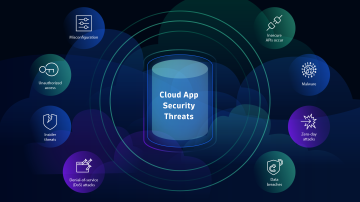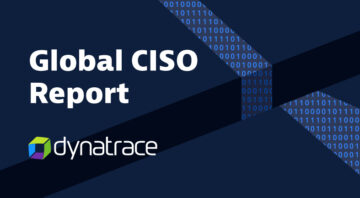
Cloud application security is becoming more of a critical issue as cloud-based applications gain popularity. The cloud allows a modular approach to building applications, enabling development and operations teams to quickly create and deploy feature-rich apps. However, the same characteristics that make cloud-native applications nimble and agile can also introduce a variety of cloud application security risks.
Incorporating cloud application security practices is an effective way for organizations to avoid application security risks, ensure a smoothly running software development lifecycle (SDLC), and establish an overall strong security posture. However, implementing these practices within DevSecOps teams can often be extremely challenging for complex, microservices-based, cloud-native applications.
What is cloud application security?
Cloud application security is a combination of policies, processes, and controls that aim to reduce the risk of exposing cloud-based applications to compromise or failure from external or internal threats.
Cloud application security generally involves authentication and access control, data encryption, identity and user management, and vulnerability management. It also entails secure development practices, security monitoring and logging, compliance and governance, and incident response.
Cloud application security practices enable organizations to follow secure coding practices, monitor and log activities for detection and response, comply with regulations, and develop incident response plans.
Many organizations host applications that are distributed over hybrid cloud environments and have some combination of private cloud, public cloud, and on-premises resources. Cloud application security is a shared responsibility between the cloud service provider and the organization using the services. If your app runs in a public cloud, such as Amazon Web Services (AWS), Microsoft Azure, or Google Cloud Platform (GCP), the provider secures the infrastructure. At the same time, you’re responsible for security measures within applications and configurations.
If your application runs on servers you manage, either on premises or on a private cloud, you’re responsible for securing the application as well as the operating system, network infrastructure, and physical hardware.
What are some key characteristics of securing cloud applications?
Cloud applications have several important characteristics that require a specific approach to secure effectively and properly to have a good security posture.
Open source software
To produce applications rapidly, developers often rely on open source software for the application’s primary building blocks. Research estimates that nearly every software program (96%) includes some kind of open source software component, and almost half of those applications (48%) expose high-risk vulnerabilities.
Using open source software can help accelerate development because developers don’t need to reinvent the wheel with every new application build. For example, if organizations build an app to handle data flows from multiple sources, they might find open source application programming interfaces (APIs) that eliminate the need to build key connectors from scratch.
However, open source software is often a vector for security vulnerabilities. To properly secure applications, developers must be able to identify and eliminate these vulnerabilities.
Microservices-based architecture
Applications built using microservices-based architecture can operate and interact across different cloud platforms. This diffusion provides greater flexibility, agility, and application resilience as organizations can easily connect and deploy applications in any environment. The challenge is that the apps often have multiple interdependencies that traditional security tools can’t easily track, monitor, or manage.
Container-based deployment
Containers offer an ideal way to deploy and operate modern cloud apps, but they also present two main visibility challenges. First, the short lifespan of containers makes it difficult for traditional security tools to scan them in production environments. Second, containers are typically opaque to traditional security tools, which results in blind spots.
Rapid development and iteration
Modern cloud apps are typically developed using modern methodologies, such as Agile and DevOps. The release cadence is rapid, sometimes daily or even multiple times per day.
Unfortunately, traditional security testing and software composition analysis require significant time to return results. Also, too many “critical” issues are often flagged, requiring manual investigation for each issue. This process can delay deployments or cause developers to skip security testing to meet project deadlines. Indeed, according to a CIO research, 34% of surveyed CIOs reported they must sacrifice code security to meet the demand for rapid innovation cycles.
Why is cloud application security so critical?
While cloud-native applications are transformational to businesses, their distributed nature also increases the attack surface. This provides bad actors with many new potential points of access to protected assets. It’s crucial to ensure that your organization has a robust cloud application security strategy to establish a strong security posture.
Robust cloud application security is crucial to implement in your business. This is because attacks against application-level vulnerabilities are the most common type of attack. The financial services sector alone saw a surge in web application and API attacks of 257% from 2021 to 2022.
Likewise, attacks on open source libraries have increased. Recent examples include the Heartbleed vulnerability in 2014, the attacks on Apache Struts in 2017, and Log4Shell in 2021. In these cases, vulnerabilities in open source libraries enabled attackers to compromise applications and cause chaos for thousands of organizations. Some organizations suffered ongoing revenue and reputation loss, along with reduced user trust.
Interoperability also plays a critical role in cloud application security. The volume of connections leveraged by cloud applications and the use of APIs to communicate between microservices is ever-increasing. Organizations require improved ways to monitor and manage their application stack, no matter where it resides.
Challenges of effective cloud application security
Common challenges of securing cloud applications include the following:
Difficulty identifying open-source vulnerabilities
As mentioned earlier, about 70% of the codebase of modern applications are now made up of open source software. Much of open source software contains known vulnerabilities. Developer tools, such as Software Composition Analysis, often produce a large number of false positive alerts. These alerts tend to slow down development. Moreover, common production tools like network scanners, can’t correctly detect open-source vulnerabilities inside containers.
Lack of security automation and DevSecOps maturity
Security tools that require manual steps, configurations, and custom scripts slow down the pace of development. Tools that require time to run and produce results do the same. In a CISO survey, 86% of CISOs say automation and AI are critical for a successful DevSecOps practice and overcoming resource challenges. However, only 12% report having a mature DevSecOps culture. Consequently, 81% of CISOs say they’re concerned they will see more security vulnerability exploits if they don’t find a way to make DevSecOps work more effectively.
Too many security point solutions
Cloud application security tools only work if developers can integrate their findings. The same CISO research found that 97% said the use of too many point solutions for specific security tasks is causing problems. Another 75% reported that team silos and the proliferation of security point solutions throughout the DevSecOps lifecycle increase the risk of vulnerabilities slipping through to production.
Modern development practices hamper zero-day vulnerability detection
Although modern development tools — such as open source software and microservices-based application architecture — make applications more flexible, they also increase the threat horizon for vulnerabilities. In the CISO research, 68% of respondents said vulnerability management has become more difficult as the complexity of their software supply chain and cloud ecosystems has increased. Similarly, 76% said the time between discovering a zero-day attack and patching all instances of vulnerable software is a significant challenge to minimizing risk.
Siloed visibility
Traditional security tools have a siloed view of vulnerabilities. These tools can’t properly assess the risks of microservices-based applications and they can’t see beyond cloud boundaries. As a result, these tools can’t give you a complete picture of your application. They also don’t let you enforce security policies consistently across boundaries. Instead, teams adopt multiple products — different products for different environments — and then stitch things together. The typical result is poor communication across tools and teams.
Cloud Application Security Threats
Cloud applications are also vulnerable to a variety of security threats. Here are some of the most common ones:
- Misconfiguration refers to a mistake or error in the configuration settings of a cloud application that can potentially introduce security vulnerabilities or expose sensitive data. Misconfigurations are common and can occur at various levels within a cloud application stack, including the operating system, web server, application server, database, and more.
- Unauthorized access occurs when an attacker gains access to a cloud application or resource without authorization. This could happen through stolen passwords, weak authentication, or vulnerabilities in the application itself.
- Insider threats specifically focus on security risks originating from individuals within an organization who have authorized access to a cloud application or resource that misuse that access. This could be done to steal data or launch attacks.
- Denial-of-service (DoS) attacks can be used to overwhelm a cloud application with traffic, making it unavailable to legitimate users. This can be done by sending large amounts of spam or malicious traffic to the application.
- Insecure APIs occur when APIs interact with cloud applications and resources. If an API is not properly secured, attackers could use it to gain unauthorized access to data or systems.
- Malware can infect cloud applications and resources, giving attackers control. This could be used to steal data, launch denial-of-service attacks, or disrupt operations.
- Zero-day attacks exploit vulnerabilities in software that the software vendor is unaware of. These attacks are often challenging to defend against because no patch is available.
- Data breaches occur if data is not adequately protected. Cloud applications often store sensitive data, such as customer PII or financial information.
Cloud Application Security Best Practices
Here are some cloud application security best practices to help you protect your data and applications:
- Use strong passwords and authentication methods.
Weak passwords are one of the most common ways for attackers to gain access to cloud applications. Strong passwords and authentication methods, such as multifactor authentication, are necessary to protect your accounts. - Keep libraries and dependencies up to date.
Software vendors regularly release security patches to fix vulnerabilities in their libraries. Installing these patches as soon as they’re available is vital to protect your cloud applications from attacks. - Implement least privilege access control.
Least privilege access control is a security principle that states that users should only have the access they need to perform their jobs. This helps to reduce the risk of unauthorized access to cloud applications and data. - Monitor cloud applications for suspicious activity.
Monitoring cloud applications for suspicious activity is an ongoing process that involves a combination of automated tools, human expertise, and proactive threat detection. This can help you to adapt to evolving threats and respond to security incidents quickly. - Use a strong cloud security solution to protect against threats.
A robust cloud security solution can help you protect your cloud applications from threats like data breaches, malware, and denial-of-service attacks. It requires a combination of technical tools, security policies, and a proactive approach to protect your cloud resources and data from evolving cybersecurity threats.
Modern cloud application security with Dynatrace
Due to the continuously evolving and accelerating pace of digital transformation, organizations are increasingly finding it challenging to keep up. While also ensuring secure, high-performing applications, organizations must evolve from traditional, manual security practices to a more intelligent, automated approach to cloud application security. Combining cloud application security and observability data into a unified analytics platform is beneficial for organizations to improve their overall application security posture.
For organizations looking to secure their applications at runtime and ensure frictionless performance, Dynatrace can help address key challenges to deliver next-generation application security. Dynatrace OneAgent provides teams with an observability-driven approach to security monitoring, informing your teams of any vulnerabilities or attacks as they arise in real time. Dynatrace incorporates security into each phase of the SDLC, providing a unified platform for real-time vulnerability analysis and remediation task automation. Powered by causal AI, rooted in automation, and optimized to work within DevSecOps and Kubernetes frameworks, the Dynatrace platform can help bridge the gap between monolithic and microservices-based architectures in any cloud.



